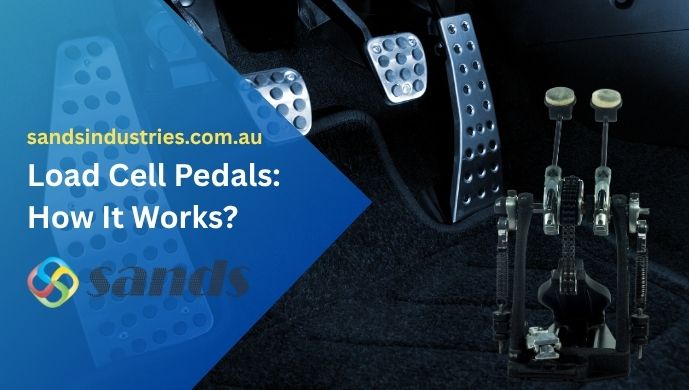Load Cell Pedals Explained: The Game-Changer in Sim Racing Performance

If you’re into sim racing, you already know precision is everything. Whether you’re shaving milliseconds off lap times or mastering corner exits, the difference between winning and losing often comes down to control. And that’s where load cell pedals come into play.
In this guide, we’ll cover everything from what load cell pedals are, how they work, and why they’re better than traditional potentiometer-based pedals, to how major brands like Moza, Thrustmaster, Fanatec, and Simagic are pushing boundaries—and how Sands Industries supports this high-performance tech with world-class load cell manufacturing.
What Are Load Cell Pedals?
Load cell pedals use a force sensor (a load cell) to measure how hard you press the brake—not how far. This is a massive difference from traditional pedals, which rely on position (potentiometers or hall sensors).
👉 With load cells, it’s all about pressure sensitivity, just like in a real race car. This provides:
- Greater consistency under braking
- Better trail-braking control
- Realistic racecraft simulation
It’s no wonder sim racers on Reddit, YouTube, and Twitch are making the switch—from beginners to esports pros.
How Do Load Cell Pedals Work?
A load cell is a small sensor (usually strain gauge-based) that converts physical force into an electrical signal. When you press the brake, the force applied deforms the load cell ever so slightly, generating a voltage change. This voltage is then processed by a controller, giving the sim racing software real-time braking feedback based on force—not travel.
Here’s what that means in practice:
- Your braking becomes repeatable under all conditions.
- Lock-ups and under-braking are reduced.
- You can finally trust your muscle memory.
Are Load Cell Pedals Worth It?
In a word—yes. Ask any serious racer, and they’ll tell you that load cell pedals:
- Provide realism comparable to high-end racing hardware
- Improve lap times and consistency
- Feel closer to real race cars (especially in F1, GT, and rally simulations)
- Last longer due to fewer moving parts
Reddit threads, fan forums, and review sites agree: load cell pedals make you faster—and more in control.
Sim Racing Load Cell Pedal Brands You Need to Know
✅ Moza Load Cell Pedals
- The Moza CRP2 and Moza SR-P load cell pedals are praised for their industrial-grade sensor precision.
- The CRP2 features customizable spring resistance, full-metal build, and modular mounting—making it a crowd-favorite in 2024 sim racing setups.
✅ Fanatec Load Cell Pedals
- The Fanatec CSL Elite Load Cell Kit converts potentiometer setups into pro-grade load-cell systems.
- Fanatec pedals support PC, Xbox, and PlayStation, making them ideal for cross-platform racers.
✅ Thrustmaster Load Cell Pedals
- Newer models like the T-LCM pedals offer 100 kg brake force, great for those coming from Logitech G29 setups.
✅ Simagic, SimRuito & DIY Builds
- High-end builders like Simagic cater to professional setups, while DIY sim racers use modular load cells (like Sands’ Model 1010) to customize their own rigs.
How to Set Up and Calibrate Load Cell Pedals
Setting up load cell pedals is straightforward—but calibration is key:
- Mount your pedals firmly to avoid flex during heavy braking.
- Use manufacturer software to calibrate max and min force ranges.
- In-game, fine-tune brake sensitivity, dead zones, and curves.
- Consider upgrading pedal springs or rubber stoppers for more feedback.
Pro tip: Some racers even use real racing shoes to maximize control and avoid fatigue over long stints.
Why Sands Industries Supports the Sim Racing Revolution
At Sands Industries, we’re not just suppliers—we’re engineers. Our load cell sensors are already used in industrial weighing, robotics, and automation across Australia. Now, we’re applying the same high-precision tech to sim racing components.
Whether you’re building a sim rig, manufacturing a pedal set, or prototyping your own gear—we supply:
- Custom and OEM load cells for brake pedals
- IP-rated sensors for long-term use
- Calibration support and signal amplification guidance
- Local Australian warehousing and express delivery
Looking to build or upgrade your setup? Let’s race ahead—together.
Where to Buy or Build Your Load Cell Pedals
🛒 Browse our precision load cells:
👉 Load Cell Shop – Sands Industries
🔧 Need OEM parts for your pedal build?
👉 Contact Us for Bulk Orders
💬 Need help choosing the right load cell sensor for your brake pedal project?
📧 support@sandsindustries.com.au | 📞 +61 477 123 699
Conclusion: The Fastest Pedal Wins
If you’re serious about sim racing performance, load cell pedals are a must-have upgrade. They bring realism, precision, and confidence that potentiometer pedals simply can’t match. With names like Moza CRP2, Fanatec CSL, and Thrustmaster T-LCM all leading the charge, there’s never been a better time to make the switch—or build your own.
Sands Industries is proud to be fuelling the next generation of sim racing gear with world-class load cell technology. Whether you’re a DIYer, a startup brand, or an esports pro, we’ve got your back — from sensor to victory.
